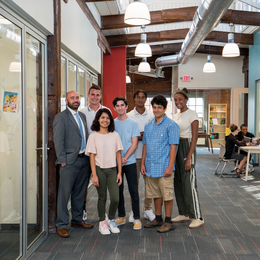
At the start of the year, students arriving at AIM Academy’s Conshohocken campus witnessed the unveiling of a dynamic new wing for upper school students. Constructed in part through a $500,000 grant from the Commonwealth of Pennsylvania, this remarkable new space is equipped with collaborative workstations, flexible classrooms, and advanced technology designed to reflect the specific needs and learning styles of the student body. Head of School Chris Herman describes the space as looking “more like a 21st century library than a traditional high school.”
The new Upper School Collaborative space is a gleaming symbol of the forward progress AIM Academy has made since opening its doors 13 years ago. The school’s first class consisted of just 24 students, as compared with this year’s class of 352 students. More importantly, AIM Academy has significantly augmented its ability to help students with language-based learning differences achieve their full potential.
“This is a place where gifted kids who learn differently bring their passions to life,” Herman says. “These are kids who might have had their heads down when they first got here because they had been underserved elsewhere, but now they’re playing violins and building amazing robots in the STEAM lab, winning league championships in athletics, and traveling the world.”
As a co-educational, college-preparatory school for children in grades one through 12, AIM Academy is rooted firmly in the science and research of language-based learning differences such as dyslexia, dysgraphia, and dyscalculia. Likewise, AIM’s founders started the AIM Institute for Learning & Research in 2006 as a conduit for developing evidence-based practices for teachers, both within AIM Academy and beyond its walls.
“The Institute has always part of our bigger vision,” says AIM Co-founder and AIM Institute Co-director Pat Roberts. “Those who come to AIM Academy are the lucky few, and that is just not good enough if we want to see literacy rates change everywhere.”
“We can have all these great interventions in place, and we can have great programming, but we also need to look at the fidelity of these practices and make sure they’re being delivered the right way,” adds Julia Salamone, a lower-school teacher and curriculum and instructional leader at AIM Academy, as well as a curriculum developer and coach at the AIM Institute for Learning & Research. “When you support teachers with evidence-based practices, the outcome for the students is going to be much better, and that’s a really beautiful thing.”
AIM Academy has forged vital partnerships with other institutions devoted to helping students thrive, including Yale University’s Haskins Laboratories. As the first educational partner of the Haskins Global L2 (Language and Literacy) Innovation Hub, AIM will bring neuroscience research into the classroom to boost language skills in children at risk for reading-based learning difficulties. “Partnerships like Haskins will change the way instruction happens everywhere, not just at AIM,” says AIM Co-founder and AIM Institute Co-director Nancy Blair. “Our goal is to address the literacy crisis in all classrooms.”
AIM Academy has also linked arms with area universities to offer dual-enrollment programs designed to introduce high school seniors to “an authentic college experience,” as Herman calls it. While many students will take these classes at Cabrini University, students with more specific interests may take classes at University of the Arts or Drexel’s Close School of Entrepreneurship. Every senior participating in one of these dual-enrollment programs has access to an on-campus counselor to help learn the advocacy skills needed to succeed in college.
“We believe if you come to school here, college is the goal,” Herman says. “So we are preparing every student for that experience. It’s great our students get college credits while they’re still in high school, but that’s gravy. It’s more about getting them familiar with the experience. Research shows experiences like this make students more likely to finish their freshman year [of college], and if they finish freshman year, they are more likely to finish all four years.”
Another resource designed to prepare students for life after AIM is the Center for Global Leadership. AIM created the center to help students from grades 1 to 12 make strong connections to the world and become responsible, engaged global citizens—through discussions relating to social justice and sustainability, as well as through writing assignments and STEAM-related projects. The center is also home to the Global Scholars program, which guides high school students through an intensive course of study that immerses them in other cultures. For example, some Global Scholars will take a yearlong course in Peruvian culture, which includes travel to Peru for a service experience and others will learn about and travel to Spain.
“One of our goals has always been to bring extraordinary opportunities to students who learn differently,” Herman says. “We offer just about anything students might find in any other high school people would consider elite, and we also offer an approach to education that is tailored toward them. While we often say that our students have to learn like this, we believe every child should learn like this. I wish every child had access to a model like ours.”
AIM Academy
1200 River Road
Conshohocken, Pa.
AIMpa.org
(215) 483-2461
Photography by Jody Robinson
Published (and copyrighted) in Suburban Life Magazine, September 2018.
.
.
.


